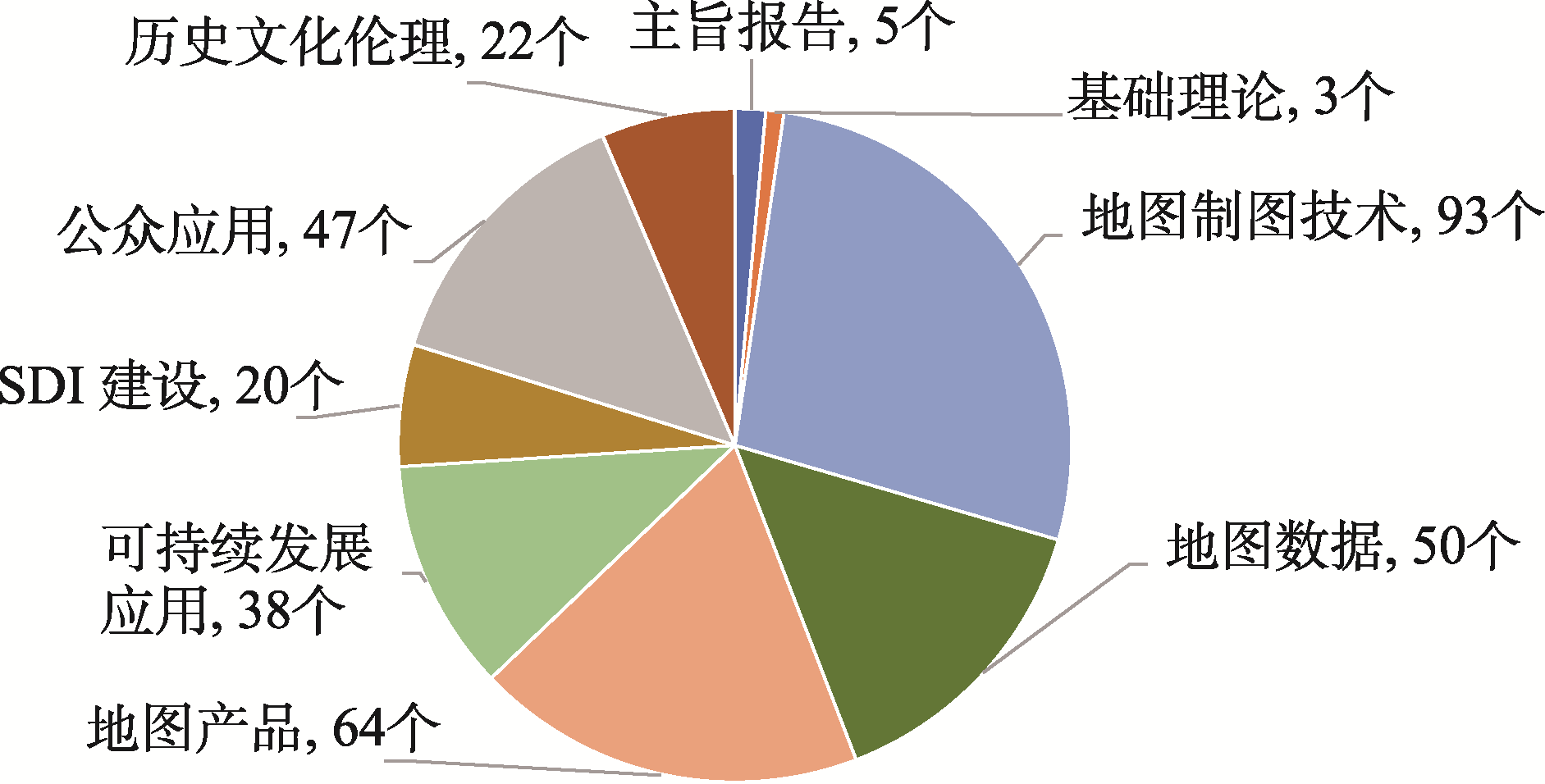

从第31届国际制图大会看地图制图学的研究进展
|
刘纪平(1967— ),男,陕西高陵人,博士,研究员,研究方向为空间辅助决策、网络地理信息挖掘与监管、应急地理信息制图与服务等。E-mail: liujp@casm.ac.cn |
Copy editor: 蒋树芳
收稿日期: 2024-01-02
修回日期: 2024-01-15
网络出版日期: 2024-03-26
基金资助
国家重点研发计划项目(2022YFC3005700)
中国测绘科学研究院基本业务费项目(AR2205)
Research Progress of Cartography Highlighted by the 31st International Cartographic Conference
Received date: 2024-01-02
Revised date: 2024-01-15
Online published: 2024-03-26
Supported by
National Key Research and Development Program of China(2022YFC3005700)
the Basic Scientific Research Foundation of the Chinese Academy of Surveying and Mapping(AR2205)
2023年8月13日至18日,第31届国际制图大会在南非开普敦举行。本文首先简要介绍了第31届国际制图大会概况。然后,在详细分析大会专题报告的基础上,重点归纳和总结了国际上地图制图学在基础理论、地图制图与地理信息技术、地图数据、地图产品、空间数据基础设施建设、公众应用、可持续发展和历史文化伦理八个方面的研究新热点,并分析得到了以下特点:一方面地图制图更加注重多要素融合制图、用户/场景体验增强和快速制图能力;另一方面,地理信息技术在多模泛在感知、大数据融合处理、人工智能分析、知识构建与服务等方面不断深化;此外,面向资源管理、生态保护、社会发展等的全球/区域/国家/城市可持续发展应用,已成为各国政府机构、科研机构、产业企业等共同努力的热点方向。另外从国际地图大赛获奖地图可以看出地图可视化方法融入了更多的现代元素和文化印记,更加注重“人-图”互动。最后,探讨了大数据与人工智能时代地图制图学在理论体系、技术方法和应用服务方面的发展趋势,并对我国地图制图学科发展与国际合作提出了建议。

刘纪平 , 车向红 , 王勇 , 徐胜华 , 孙玉杰 , 迟晋浙 , 杜凯旋 . 从第31届国际制图大会看地图制图学的研究进展[J]. 地球信息科学学报, 2024 , 26(1) : 3 -14 . DOI: 10.12082/dqxxkx.2024.230788
The 31st International Cartography Conference (ICC) was held in Cape Town, South Africa from August 13 to August 18 in 2023. This paper first introduced the overview of the 31st ICC, the participation of Chinese experts and enterprise. Secondly, based on the technical reports during the ICC2023, new research hotspots of cartography were analyzed and summarized from eight aspects including the basic theory of cartography and technologies of cartography, map data, map products, and Spatial Data Infrastructure (SDI) construction, public applications, sustainable development applications and historical and cultural ethics. We concluded some obvious hotspots that the traditional mapping fields have paid more attention to multi-element fusion mapping, user and scenario experience enhancement and rapid mapping capabilities; On the other hand, the emerging geographical information fields have focused on multi-modal ubiquitous sensing, big data fusion processing, artificial intelligence analysis, knowledge construction and services which have been deepened continuously; In addition, government agencies, scientific research institutions, industrial enterprises across the world have continuous passion on global, regional, national and urban sustainable development cartographic applications for resource management, ecological protection, social development. Subsequently, the new characteristics of map visualization methods from the award-winning maps were explored as well which incorporate more modern elements and cultural imprints, and emphasize people-map interaction. Afterwards, in the era of big data and artificial intelligence, the development trend of theoretical systems, technical methods and application services for cartography in the next few years are discussed. That is, the theoretical system of cartography becomes more professional and refined. In the era of artificial intelligence, the technical content of cartography becomes more knowledgeable. Cartography application services become more ubiquitous driven by big data. Cartography plays a more profound role in supporting the sustainable development of the United Nations. In the last place, some suggestions were put forward for the development of the cartography discipline in China. For example, in the future, we must make full use of the ICA international platform to continuously establish and improve a new theoretical system of cartography in the intelligent era, break through the key core technologies of cartography, and promote the high-quality development of cartography in our country with a global perspective. Meanwhile, we should pay more attention to the international frontier developments in important and emerging research fields such as geospatial data fusion, knowledge construction, spatial analysis, ubiquitous mapping, geographic intelligence, and data quality, and strengthen scientific and technological exchanges and cooperation between relevant domestic and foreign research institutions. A more proactive and proactive opening-up strategy should be implemented to promote the continuous improvement of the international influence of cartography research.

表1 不同类型地图可视化特点Tab. 1 Visualization characteristics of different types of maps |
| 序号 | 地图类型 | 地图特点 |
|---|---|---|
| 1 | 挂图类 | 结合传统绘画艺术和文字、音乐、语音和摄影等现代艺术和文学作品等文字、图片、音频、视频等多种信息展示手段,使得地图可视化更加生动,在地图空间定位等基本功能基础上,更加突出地图的艺术美感(图4(a)—图4(b)) |
| 2 | 故事类 | |
| 3 | 实体类 | |
| 4 | 航空(海)类 | 为全力保障航空、海运安全性,可视化与飞行和航海相关的地理要素和航行要素类型更为细化,如注重海洋和陆地地形地貌等可视化表达(图4(c)) |
| 5 | 地图集(册)类 | 相比传统的静态制图,结合多源大数据更加主动自然、社会和人文等地理现象时空变化的地图可视化表达(图4(f)) |
| 6 | 教育类 | 相比传统纸质制图介质,结合数字化与物理等多元化介质,让地图教育更加常态化;地图制图从传统2D模式向3D和4D模式转化,更加注重地图交互性,地图用户群体更加广泛(图4(d)) |
| 7 | 数字地图及服务类 | 更加关注WEB端时空大数据的快速在线分析和可视化,制图过程可快速个性定制和自适应 (图4(e)) |
图4 国际地图大赛部分获奖作品注:数据来源: https://icc2023.org/index.php/international-map-exhibition/。 Fig. 4 Parts of the award-winning works from the International Map Exhibitions |
| [1] |
|
| [2] |
|
| [3] |
|
| [4] |
|
| [5] |
|
| [6] |
|
| [7] |
|
| [8] |
|
| [9] |
|
| [10] |
|
| [11] |
|
| [12] |
|
| [13] |
|
| [14] |
|
| [15] |
|
| [16] |
|
| [17] |
|
| [18] |
|
| [19] |
|
| [20] |
|
| [21] |
|
| [22] |
|
| [23] |
|
| [24] |
|
| [25] |
|
| [26] |
|
| [27] |
|
| [28] |
|
| [29] |
|
| [30] |
|
| [31] |
|
| [32] |
|
| [33] |
|
| [34] |
|
| [35] |
艾廷华. 深度学习赋能地图制图的若干思考[J]. 测绘学报, 2021, 50(9):1170-1182.
[
|
| [36] |
|
| [37] |
钱海忠, 武芳, 王家耀. 自动制图综合及其过程控制的智能化研究[M]. 北京: 测绘出版社, 2012.
[
|
| [38] |
王米琪. 基于图卷积神经网络的道路网模式识别[D]. 武汉: 武汉大学, 2021.
[
|
| [39] |
李想, 李宏伟. 深度学习方法在地图点注记配置中的应用研究[J]. 出版与印刷, 2022(2):49-56.
[
|
| [40] |
于洋洋, 贺康杰, 武芳, 等. 面状居民地形状分类的图卷积神经网络方法[J]. 测绘学报, 2022, 51(11):2390-2402.
[
|
| [41] |
钟英铭. 基于深度学习的面向制图综合的建筑物群组模式识别研究[D]. 武汉: 华中师范大学, 2021.
[
|
| [42] |
|
| [43] |
|
| [44] |
黄楠. 基于DEM及风格迁移的地形水墨风格艺术化表达[D]. 南京: 南京师范大学, 2021.
[
|
| [45] |
|
| [46] |
|
| [47] |
|
| [48] |
|
| [49] |
|
| [50] |
|
| [51] |
|
| [52] |
|
| [53] |
|
| [54] |
|
| [55] |
刘艳芳, 方飞国, 刘耀林, 等. 时空大数据在空间优化中的应用[J]. 测绘地理信息, 2019, 44(3):7-20.
[
|
| [56] |
刘纪平, 王勇, 张福浩, 等. 网络地理信息获取融合与分析挖掘[M]. 北京: 测绘出版社, 2018.
[
|
| [57] |
|
| [58] |
|
| [59] |
裴韬, 黄强, 王席, 等. 地理大数据聚合的内涵、分类与框架[J]. 遥感学报, 2021, 25(11):2153-2162.
[
|
| [60] |
|
| [61] |
刘纪平, 王勇, 胡燕祝, 等. 互联网泛在地理信息感知融合技术综述[J]. 测绘学报, 2022, 51(7):1618-1628.
[
|
| [62] |
|
| [63] |
陈军, 闫超德, 赵仁亮, 等. 基于Voronoi邻近的移动地图自适应裁剪模型[J]. 测绘学报, 2009, 38(2):152-155,161.
[
|
| [64] |
王家耀, 张天时. 制图综合[M]. 北京: 星球地图出版社, 2016.
[
|
| [65] |
戴志伟. 寻路大数据:海量数据与大规模分析[J]. 中国信息化, 2014,(S2):113.
[
|
| [66] |
廖克. 中国地图学发展的回顾与展望[J]. 测绘学报, 2017, 46(10):1517-1525.
[
|
| [67] |
|
| [68] |
|
| [69] |
|
| [70] |
|
| [71] |
|
/
| 〈 |
|
〉 |